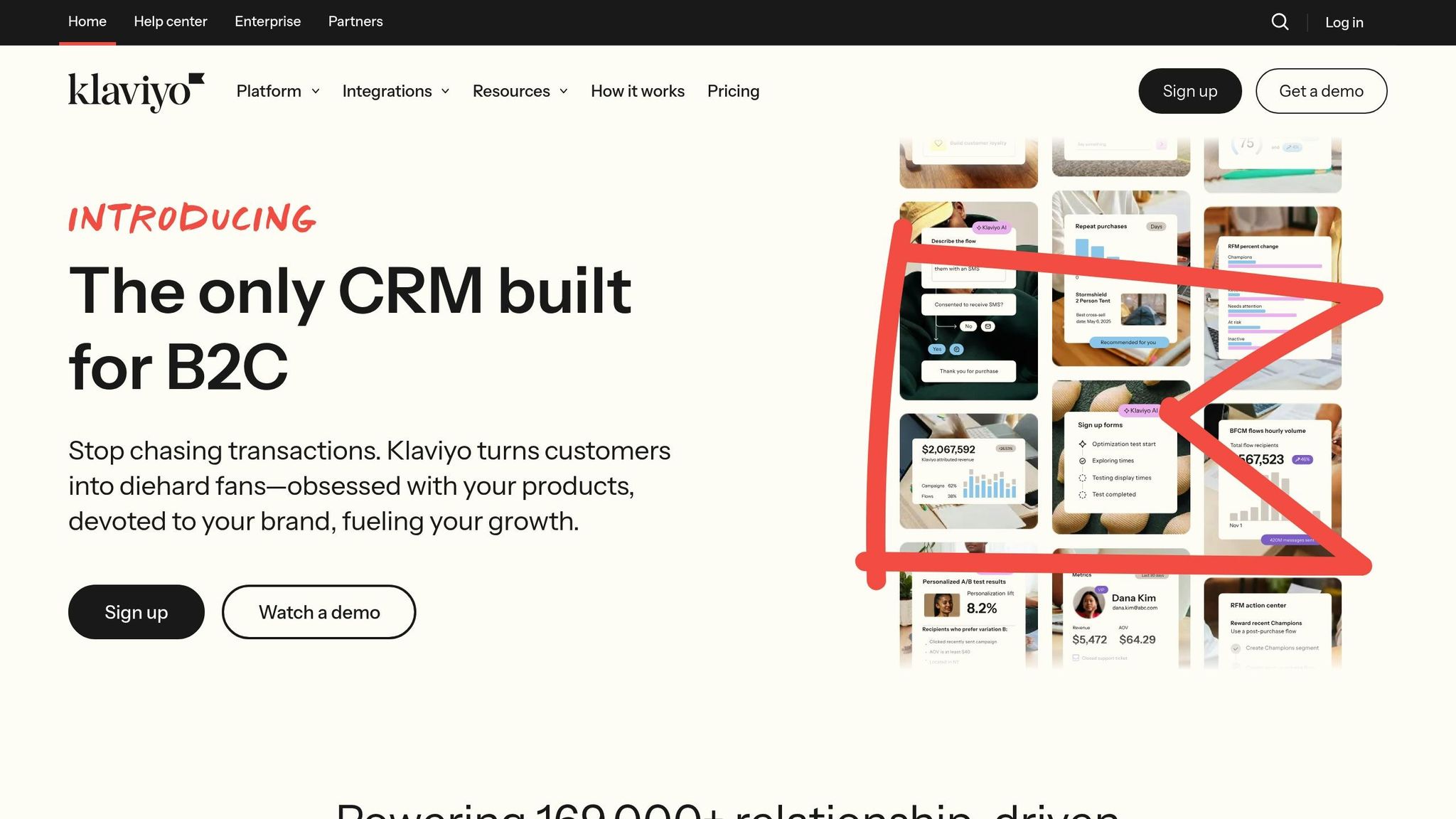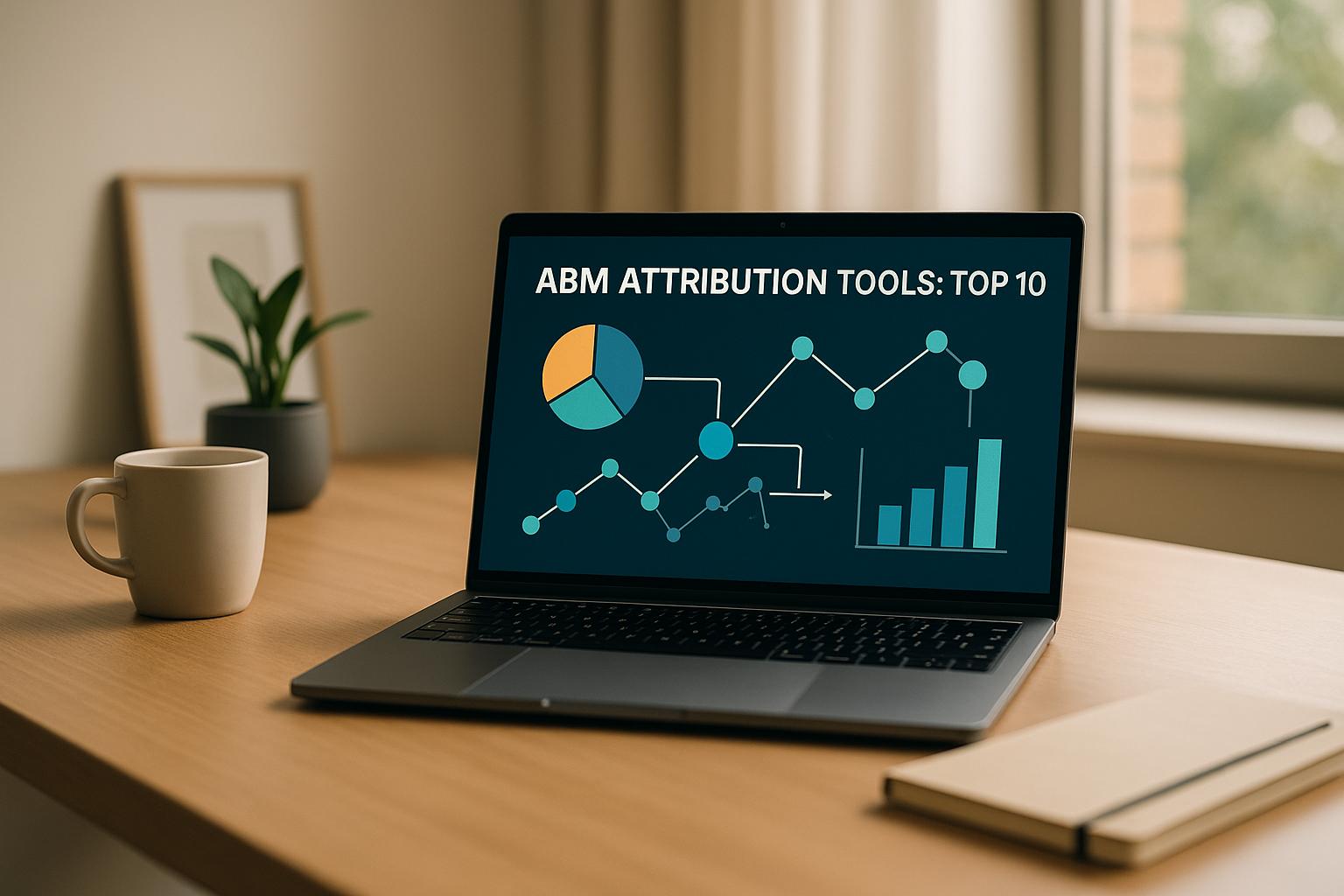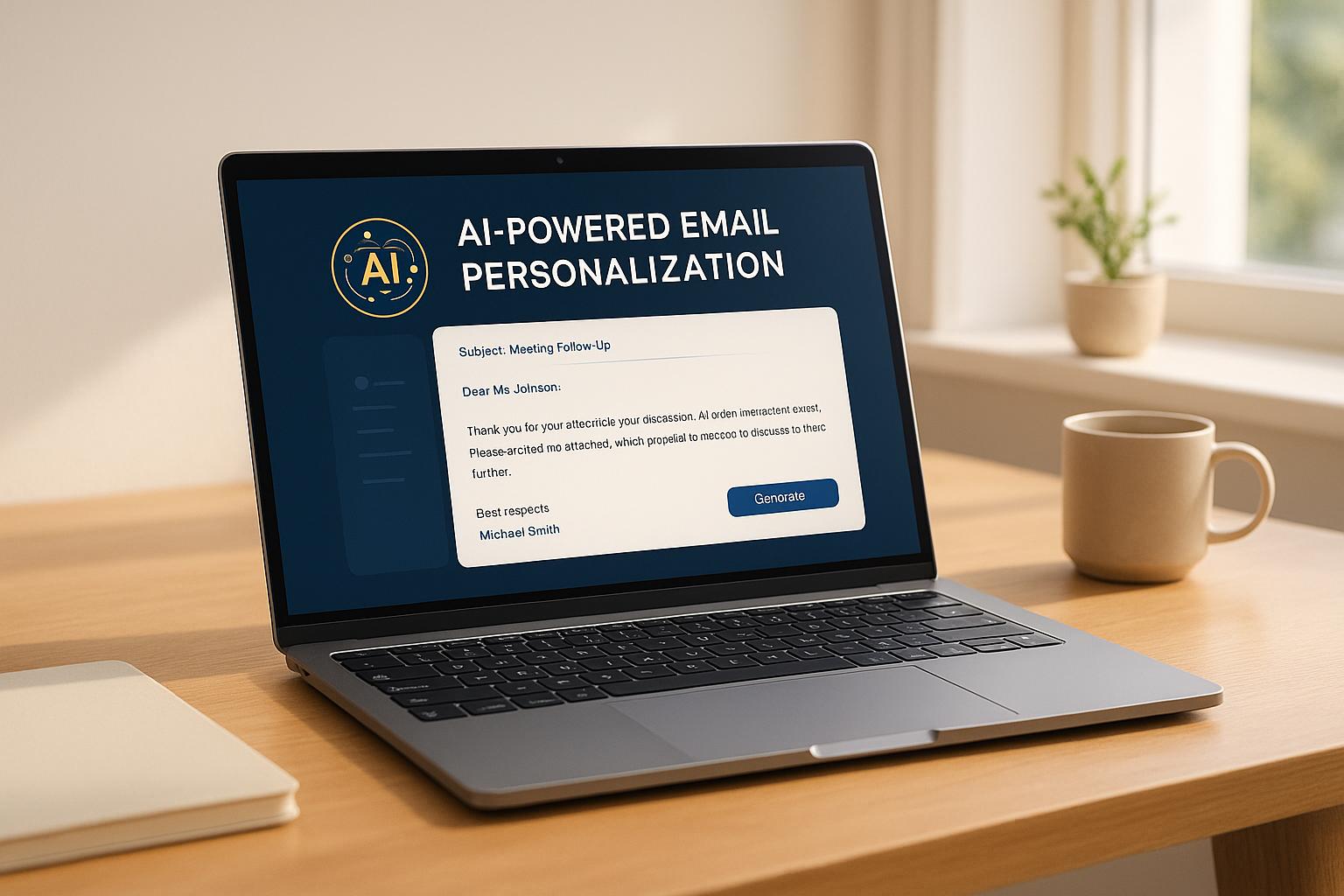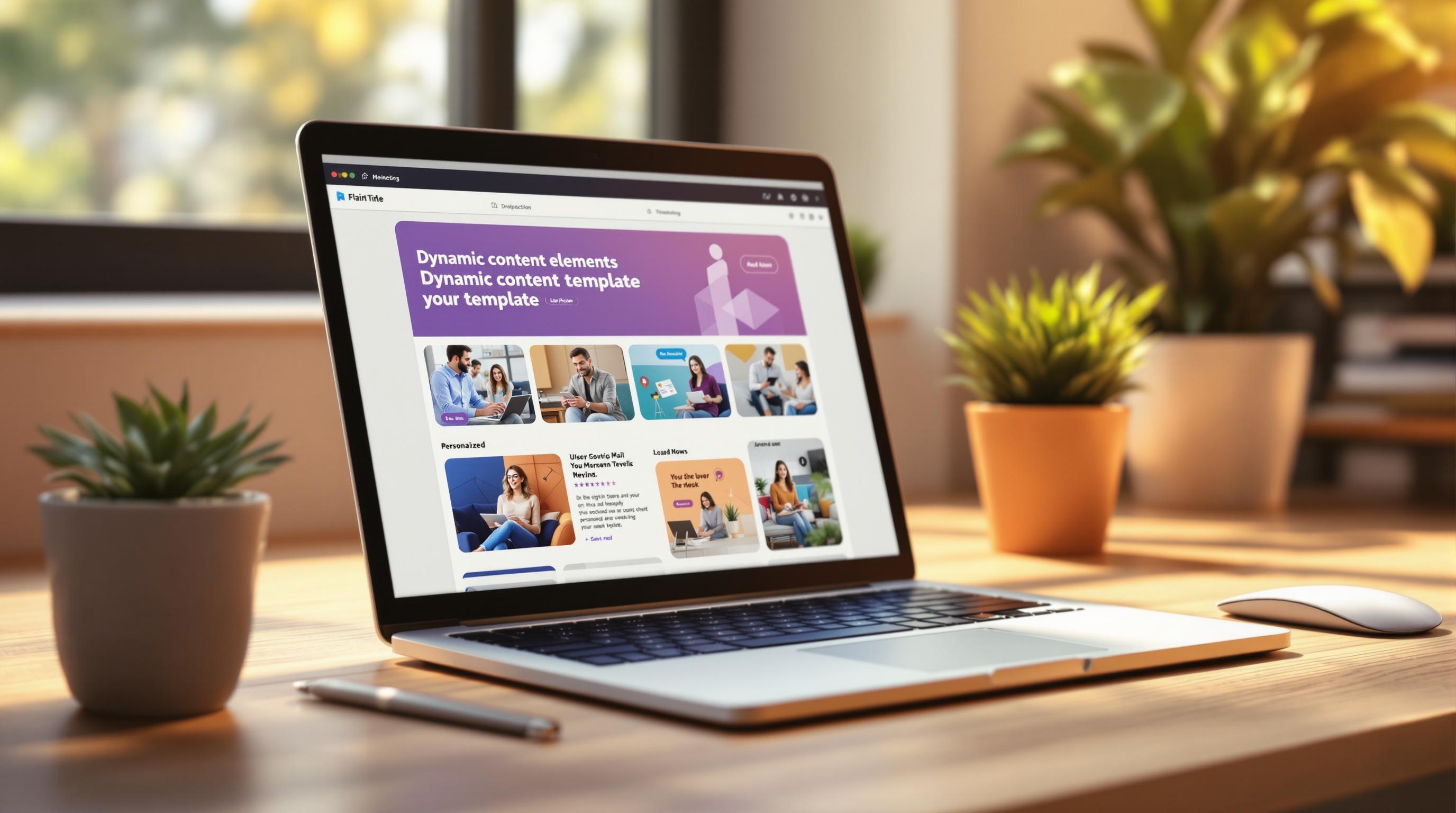Predictive analytics helps B2B email campaigns by solving common problems like poor segmentation, mistimed emails, and weak ROI measurement. It uses data to predict customer behavior, improve personalization, find the best times to send emails, and focus on high-value leads. Here's why it matters:
- Better Segmentation: Tailor emails based on customer behavior, boosting open rates by up to 14% and click-through rates by over 100%.
- Perfect Timing: Data shows emails sent on Tuesdays have the highest open rates, while Fridays drive the most conversions.
- Improved ROI: Predictive lead scoring increases conversion rates by 10%-50% and helps prioritize sales-ready leads.
- Higher Revenue: Personalized campaigns can increase email-driven revenue by 760%.
To get started, set clear goals, consolidate your data into one platform, and choose predictive tools that integrate with your CRM. Start small, test, and refine based on results. Predictive analytics transforms email marketing into a data-driven strategy that delivers measurable results.
Unlock the Future: Klaviyo Predictive Analytics Explained

Common B2B Email Marketing Problems
Navigating the challenges of B2B email marketing can feel like walking a tightrope. Traditional methods often fall short, leaving marketers struggling to engage prospects and drive revenue. Below, we dive into some of the biggest hurdles B2B marketers face.
Poor Segmentation and Personalization
One major issue is failing to tailor messages to individual audience needs. Many campaigns rely on outdated segmentation methods, lumping prospects together and delivering one-size-fits-all content. The result? Messages that miss the mark entirely.
The consequences are hard to ignore. Between 25-50% of marketing emails are either deleted or marked as spam without being opened. Poor personalization leads to what many recipients see as "junk" emails, eroding trust in the brand. Over-automation and irrelevant messaging only add to the problem, often stemming from outdated or incomplete data.
These missteps come at a time when personalization is more critical than ever. 73% of business buyers expect interactions to be tailored to their needs, and 76% of customers feel frustrated when marketing falls short of their expectations. Add to that the complexity of the B2B purchase journey - 77% of buyers describe it as very complex - and it’s clear that generic messaging won’t cut it.
"B2B email personalization helps prospective customers get relevant information while establishing brand trust." - Christine Crandell, President, New Business Strategies
Wrong Timing and Email Frequency
Finding the right balance between email timing and frequency is another common challenge. Send too many emails, and you risk overwhelming your audience; send too few, and you lose relevance and revenue opportunities.
The stats tell the story. 44% of consumers unsubscribe when brands send too many emails, and 73% cite frequent emails as their main reason for opting out. While many brands aim for 2–4 emails per month, the "right" frequency depends on more than just guesswork.
Timing also plays a pivotal role. For example, Tuesday emails see the highest open rates at 11.36%, while Friday emails drive the most conversions. Even specific dates matter: targeting the 10th and 24th for opens, the 2nd and 26th for clicks, and the 1st and 30th for conversions can make a measurable difference.
Failing to get the timing and frequency right doesn’t just hurt engagement - it can harm your sender reputation. Subscribers may mark your emails as spam or unsubscribe altogether. Over-emailing also increases costs without delivering proportional results, while under-emailing leaves money on the table.
The takeaway? Data-driven strategies are essential for fine-tuning both timing and frequency.
Difficulty Predicting Results and ROI
Measuring the success of B2B email campaigns is no easy task. Traditional ROI frameworks often oversimplify the complex nature of B2B sales, making it tough to justify marketing spend or improve strategies.
The challenges are compounded by long sales cycles and multi-channel touchpoints, which make it difficult to connect early marketing efforts with final revenue. Offline conversions, in particular, are hard to track and incorporate into ROI metrics.
The numbers highlight how widespread this issue is. 87% of B2B marketers find it increasingly difficult to measure the long-term impact of their campaigns, and 78% of CMOs are prioritizing ROI measurement more than ever. Despite this, 40% of senior leaders still focus on RoAS when evaluating performance.
Data silos further complicate things by preventing a unified view of marketing’s impact. Many teams rely on vanity metrics rather than revenue-focused insights, while standard attribution models often fail to capture the nuances of B2B deals. On top of that, privacy regulations limit what data can be collected and used.
Another roadblock is the lack of alignment between sales and marketing. Only 16% of B2B teams report strong collaboration, and 96% of companies with poor alignment see customer dissatisfaction. When 94% of buyers get frustrated by disjointed interactions between sales and marketing, it’s clear that better coordination is crucial for accurate forecasting.
Addressing these challenges is key to unlocking the full potential of predictive analytics in B2B email marketing.
How Predictive Analytics Solves B2B Email Problems
Predictive analytics takes the uncertainty out of B2B email marketing. By digging into behavioral patterns and engagement metrics, it helps businesses overcome challenges and improve results.
Better Segmentation and Personalization
Struggling with poor segmentation and generic messaging? Predictive analytics changes the game by offering a deeper understanding of your audience. Instead of just looking at basic demographics, it examines customer behavior, preferences, and past interactions to create more targeted and effective audience groups.
The numbers back this up: segmented email campaigns generate 58% of all revenue, and personalized emails achieve six times higher transaction rates. Even small tweaks, like personalized subject lines, can boost open rates by 26%.
Some brands are already seeing incredible results. In 2025, PUMA teamed up with SAP Emarsys to scale personalization. Using dynamic recommendations and AI-powered send-time optimization, they saw triple-digit year-over-year growth, increased open rates by 5–10%, and multiplied email-driven revenue by five times. Similarly, Babbel used intent-based segmentation to engage older users, improving engagement by 25% and driving 50% better conversion rates.
The impact is clear: personalized email campaigns deliver 14% higher click-through rates and 10% higher conversion rates compared to generic emails. When predictive analytics powers personalization, email revenue can increase by an astonishing 760%.
Finding the Best Send Times and Frequency
Timing matters just as much as personalization. Predictive analytics takes the guesswork out of choosing when and how often to send emails. By analyzing historical engagement data - like open rates, click-through rates, and conversions - it identifies the best send times and frequencies for each audience segment.
For example, B2B professionals are most likely to engage with emails during weekdays, especially Tuesday through Thursday, and between 9 a.m. and 11 a.m.. AI tools continuously adapt to real-time data, refining these recommendations as audience behaviors shift. While two to three emails per week often work well, a broader study of 199 million emails found that sending 6.21 campaigns per week was optimal.
With predictive analytics, businesses can fine-tune their strategies, ensuring their emails land at the right time and frequency to maximize engagement.
Lead Scoring and Conversion Prediction
Predictive analytics also enhances lead scoring and conversion prediction, boosting ROI by helping businesses focus on the most promising opportunities. By analyzing historical data and predictive signals, it assigns more accurate lead scores and forecasts sales outcomes with greater precision.
The results speak for themselves. Companies using predictive analytics are nearly three times more likely to report revenue growth above the industry average. Conversion rates often improve by 10% to over 50% after adopting predictive lead scoring. Businesses using these tools report 50% more sales-ready leads and a 10% increase in average deal size.
Different industries are reaping tailored benefits. For instance, in insurance, predictive lead scoring helps identify individuals most likely to purchase policies by analyzing demographics, life events, and past interactions. In the SaaS world, predictive algorithms assess user behavior during free trials and engagement with marketing content, allowing sales teams to prioritize leads most likely to subscribe.
sbb-itb-6e7333f
How to Implement Predictive Analytics in Your Email Campaigns
Bringing predictive analytics into your B2B email campaigns might sound complex, but with the right steps, you can shift from guesswork to a data-driven strategy. Here's how to make it happen.
Set Clear Goals and Metrics
Start by defining specific, measurable objectives, such as improving open rates, increasing conversions, or reducing unsubscribes. Align your email messaging with your overall business goals, and track key performance indicators like revenue per email and customer acquisition costs. These insights can then be applied across all customer touchpoints to create a consistent, data-informed experience.
Once your goals are in place, the next step is to gather and organize your data effectively.
Connect Your Data Sources
Predictive analytics thrives on high-quality, comprehensive data. Combine customer data - like purchase history, browsing behavior, and email interactions - into a single, unified profile. A robust CRM system can serve as your central hub, and using a reporting automation platform can help consolidate data from multiple sources into actionable insights.
For example, The Willow Tree Boutique used predictive analytics to target customers with a predicted lifetime value over $500 or an average order value above $150. This strategy resulted in a 53.1% increase in revenue within just six months.
With a well-rounded dataset in place, you’ll be ready to select the right tools to bring your strategy to life.
Choose the Right Tools and Platforms
Pick a predictive analytics platform that integrates seamlessly with your CRM to ensure smooth data flow. Look for tools that offer features like lead scoring, churn prediction, and content personalization, along with strong security and compliance capabilities. The Email Service Business Directory is a helpful resource for finding email marketing platforms with built-in predictive analytics.
Costs can vary - basic plans typically start around $15–$20 per month, while enterprise-level solutions often require custom pricing.
Ease of use is another important consideration. For instance, the team at ActiveTrail saw a 25% increase in opportunities and a 20% boost in deal closings after implementing predictive lead scoring.
"The goal is not to predict; the goal is to change behavior to change outcomes. Predictive analytics is meant to guide you into the right direction to make a more data-driven decision than just guessing."
- Katie Robbert, CEO, Trust Insights
Begin with small pilot programs to test your approach before deploying it across your organization. Trend Micro, for example, used predictive analytics in an account-based marketing campaign, leading to a fourfold increase in new account engagement after initial testing.
Remember, predictions only matter if you act on them. As Eric Siegel, author of Predictive Analytics, puts it:
"Once you develop a model, don't pat yourself on the back just yet. Predictions don't help unless you do something about them. They're just thoughts, just ideas... The key is to continually test and refine your models against real-world outcomes."
- Eric Siegel, Author, Predictive Analytics
Adopting a test-and-learn mindset will allow you to refine your predictive marketing strategies as customer behaviors shift. By following these steps, you can turn your email campaigns into a powerful, data-driven tool that aligns with the principles of predictive analytics and boosts your B2B marketing efforts.
Benefits and Drawbacks of Predictive Analytics
Predictive analytics has become a cornerstone for refining segmentation, timing, and lead scoring in marketing. Today, about 95% of companies incorporate AI-driven predictive analytics into their B2B marketing strategies. Businesses that rely on analytical data for decision-making are 1.5 times more likely to achieve at least 10% revenue growth over three years.
However, this approach isn’t without its challenges. For instance, only 6% of companies excel at evidence-based business practices, and 80% of marketing leaders find it difficult to turn customer data into actionable decisions. These statistics highlight a common struggle: bridging the gap between having predictive tools and effectively using them.
The hurdles go beyond data interpretation. Training teams on AI systems can be both time-intensive and expensive. Integrating these tools with existing infrastructure often brings additional costs and technical difficulties. Plus, there’s the risk of leaning too heavily on automation, which can make customer interactions feel less personal and empathetic.
Benefits vs Challenges Comparison
| Benefits | Challenges | Mitigation Strategy |
|---|---|---|
| Higher Revenue Growth - Companies are 1.5x more likely to see 10%+ revenue growth | High Implementation Costs - Significant upfront investment in tools and training | Start small with pilot programs and scale based on performance |
| Improved Lead Scoring - 47% of businesses using intent signals see better conversion rates | Data Quality Issues - Incomplete or biased data can skew predictions | Conduct regular data validation and quality checks |
| Enhanced Personalization - Tailors experiences based on customer behavior | Skill Gaps - Shortage of qualified data analysts | Invest in team training or collaborate with external experts |
| Predictive Insights - 46% of marketers aim to use AI for predicting churn and retention | Model Accuracy Risks - Overfitting or underfitting can reduce reliability | Regularly update models and test against real-world outcomes |
| Competitive Edge - Real-time insights into customer preferences | Loss of Human Touch - Over-reliance on AI can reduce empathy in communication | Combine AI automation with human creativity and empathy |
Balancing these advantages and challenges is critical for successful implementation. Christie Horsman, CMO at Thinkific, shares:
"We're using data in terms of fit and engagement to really understand how to talk to these people and how to prioritize talking to these people, which has had a tremendous impact."
Thinkific saw their MQL to OPP (Marketing Qualified Lead to Opportunity) rate double in just three months during Q2 2024, thanks to a predictive acquisition scoring model.
The global market for predictive analytics is expected to grow to nearly $23.9 billion by 2027, with an annual growth rate of around 21%. This growth reflects the confidence in predictive analytics, despite its challenges.
To maximize its potential, focus on maintaining high-quality data, provide your team with the necessary skills through training or partnerships, and be transparent with customers about how their data is used. Since predictive models rely on historical patterns, they can struggle in rapidly changing environments. Regular updates and human oversight are essential to keep predictions accurate and relevant, tying back to earlier advice on data integration and tool selection.
Key Takeaways
Predictive analytics is changing the way B2B companies handle email marketing by tackling three major hurdles: poor audience segmentation, mistimed email sends, and challenges in forecasting ROI. Companies using AI in their email strategies see a 41% boost in open rates and a 35% rise in click-through rates.
One of the standout benefits of predictive analytics is its ability to refine customer segmentation. Instead of grouping customers into broad categories, it allows you to segment based on behaviors, preferences, and past interactions. This level of precision drives better engagement. In fact, targeted emails generate 18 times more revenue than generic email blasts.
It also takes the guesswork out of timing. By analyzing data, predictive tools identify the optimal times to send emails - when your audience is most likely to engage. This ensures your messages land at the right moment, increasing the chances of interaction.
Lead scoring is another area where predictive analytics shines. Instead of relying on basic demographic details, advanced models assess engagement trends, content preferences, and behavioral signals to pinpoint high-value leads early in the sales cycle. This makes it easier to focus on prospects with the most potential, leading to smarter strategies.
To successfully implement predictive analytics, start with clear goals, ensure your data is high-quality, and choose tools that align with your needs. Keep in mind, the accuracy of predictions depends heavily on the quality of your data - if it's incomplete or biased, the results will reflect those flaws.
With email marketing delivering an average ROI of $36 for every $1 spent, predictive analytics takes this return even further by ensuring your emails reach the right people at the right time. To explore platforms that offer predictive analytics features, the Email Service Business Directory is a great resource for comparing tools and finding the best fit for your business.
Start small, test thoroughly, and expand based on what works. Companies that embrace this approach not only see better email performance but also gain a lasting edge over competitors. By mastering these strategies, you'll establish a forward-thinking, data-driven foundation for B2B email marketing success.
FAQs
How can predictive analytics improve personalization in B2B email marketing?
Predictive analytics takes B2B email marketing to the next level by leveraging historical and real-time data to predict customer behavior. This means marketers can craft emails that feel more personal by fine-tuning content, timing, and audience segmentation.
With the ability to pinpoint leads most likely to convert and identify the ideal moments to reach out, predictive analytics makes emails more relevant and engaging. The result? Higher open rates, better click-through rates, and stronger overall campaign performance - all while providing a more tailored experience for your audience and boosting business outcomes.
How can businesses effectively use predictive analytics to enhance their B2B email marketing campaigns?
To make the most of predictive analytics in B2B email marketing, start by setting clear objectives that tie directly to your marketing goals - like improving engagement rates or boosting conversions. This way, your efforts stay focused and measurable.
Then, gather and clean your data carefully. This includes information like customer behavior, purchase history, and email interaction metrics. Keeping your data accurate and well-organized is critical for building models you can trust. Plus, ensure your data collection methods comply with privacy laws to avoid any legal issues.
Lastly, select tools and predictive models that align with your business needs. Make it a habit to test, monitor, and tweak these models regularly to keep improving their accuracy and your campaign results. Predictive analytics can help you craft personalized, targeted email campaigns that lead to stronger engagement and better ROI.
What challenges do businesses face when using predictive analytics for B2B email campaigns, and how can they overcome them?
Using predictive analytics in B2B email campaigns comes with its fair share of hurdles. Common issues include data integration difficulties, poor data quality, and bias in historical data. For instance, merging predictive models with existing CRM or marketing tools often demands a high level of technical expertise. On top of that, if the data is incomplete or inaccurate, it can significantly undermine the reliability of the predictions. Historical data biases can also lead to skewed outcomes, which may affect the fairness of the results.
To overcome these obstacles, businesses should focus on a few key areas. Start by cleaning and standardizing data to ensure it's accurate and consistent. Next, make sure predictive models are smoothly integrated with your current systems. Finally, conduct regular audits of these models to identify and address any potential biases. By tackling these challenges head-on, companies can enhance the precision and equity of their predictive analytics, leading to more impactful email campaigns.


